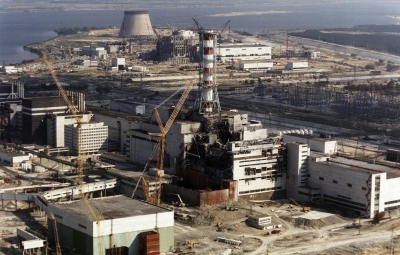
Ukraine recently commemorated the 35th anniversary of the Chernobyl disaster, considered one of the world’s worst nuclear disasters. The disaster was the result of an explosion in the fourth reactor of the Chernobyl nuclear power station, in the former USSR, which led to radiation poisoning across Ukraine and neighbouring Belarus and Russia. The exact number of victims remains a subject of intense debate because the Soviet authorities kept most of the information about the disaster hidden. Hundreds of thousands of people were evacuated from the area around the disaster site, and the exclusion zone has now become a ghostly uninhabited region.
Ukrainian authorities say the area may not be fit for humans for 24,000 years, but the site has been attracting tourists in the recent years and Ukraine wants to make it a UNESCO World Heritage Site.
During the 35th year commemoration, Ukraine’s president Volodymyr Zelensky unveiled a new nuclear waste repository at Chernobyl, where the country could store its nuclear waste for the next 100 years. On the occasion, Ukrainian government also released a document claiming that the Soviet Union (which Ukraine was then part of) knew the Chernobyl nuclear plant was dangerous and covered up emergencies there even before the 1986 disaster.
What happened on April 226, 1986?
The Chernobyl nuclear power station was situated at the settlement of Pripyat, north of Kiev in Ukraine. Built in the late 1970s on the banks of the Pripyat River, Chernobyl had four reactors, each capable of producing 1,000 megawatts of electric power.
On the night of April 25, 1986, the reactor crew at Reactor No. 4 of experiment, which was found to be poorly designed during investigation. A series of mistakes, including the disabling of automatic shutdown mechanisms, led to the nuclear chain reaction going out of control. Reactor No. 4 exploded and caught fire on April 26, 1986, shattering the building and spewing large amounts of radioactive material from the graphite reactor core into the atmosphere, which soon spread across Ukraine, Belarus, Russia and many parts of Europe. Firefighters and helicopters attempted to put out a series of blazes at the plant, but to no avail
What happened after the explosion?
The Soviet authorities made the catastrophe worse by withholding information from the public on what had happened, even though they began an evacuation of the 30,000 inhabitants of Pripyat on April 27, 1986. The world learned of the disaster only after heightened radiation was detected in Sweden on April 28. The Swedish radiation monitoring stations, more than 800 miles to the northwest of Chernobyl, reported radiation levels 40% higher than normal. After first denying any accident, the Soviet finally acknowledged the disaster on April 28. About 600,000 emergency workers and state employees who became known as “liquidators” were dispatched with little or no protective gear to help clean up the aftermath of the disaster. The details of the incident and the victim numbers were shrouded in secrecy.
Soon after the disaster, radioactive debris were buried at some 800 temporary sites, albeit at great risk to workers. Eventually, more than 100,000 people were evacuated from the vicinity and an exclusion zone was established around the station. The exclusion zone is a 30-kilometre radius area around the nuclear power plant that was evacuated in the aftermath of the explosion. It was deemed unsafe for humans to live in for thousands of years.
How many people died as an immediate result of the accident?
Thirty-one plant workers and firemen died in the immediate aftermath of the disaster, mostly from acute radiation sickness. Thousands more later succumbed to radiation-related illnesses such as cancer, although the total death toll and long-term health effects remain a subject of intense debate.
Why is it considered one of the worst disasters?
Between 50 and 185 million curies of radioactive material escaped into the atmosphere. It’s estimated that the amount of radioactive material was 400 times more than the atom bomb dropped on Hiroshima and Nagasaki during World War II.
The radioactivity was spread over large parts of Europe, including Belarus, Russia, Ukraine, Scandinavian countries, France and Italy.
The United Nations Scientific Committee on the Effects of Atomic Radiation reported that more than 6,000 children and adolescents developed thyroid cancer after being exposed to radiation from the incident, although some experts have challenged that claim.
Scientists are still in the process of gauging the extent of the damage and starting to answer questions about the long-term legacy of radiation exposure on the power plant workers, the people in the nearby community, and even their family members born years later.
What is the status of this exclusion zone and the station?
- No one is allowed to live in this exclusion zone. However, the Ukrainian government allows tourists and scientists to enter nearby areas and even the town of Pripyat for a limited period of time.
- The highly radioactive reactor core was enclosed in a concrete-and-steel sarcophagus by the end of 1986. In November 2016, a massive metal dome was erected over the remains of the reactor to stop future leaks and ensure the safety of people for generations. Containment efforts and monitoring continue and cleanup is expected to last until at least 2065.
- Regarding the other reactors of the station, Unit 2 was closed in 1991 after a fire and Unit 1 was shut down after 1996. Unit 3 of Chernobyl remained operational till 2000 when the power station was decommissioned.
What happened to the environment and animals after the accident?
Millions of acres of forest and farmland were contaminated, and in the subsequent years many livestock were born deformed. According to the International Atomic Energy Agency, mutations occurred in plants and animals after the explosion. Leaves changed shape and some animals were born with physical deformities. However, some animals are now returning in large numbers to the area. These animals include beavers, moose, wolves and wild boar, plus a wide variety of birds.
Picture Credit : Google



